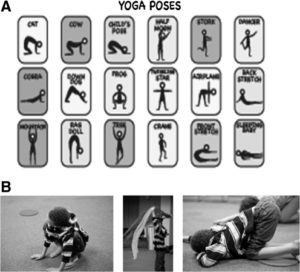Improve Autism with Yoga
By John M. de Castro, Ph.D.
“Children with autism have very different sensory experiences from other people, and these responses often cause their bodies to get stuck in fight, flight, or freeze modes that divert blood from the digestive organs to the skeletal muscles. This activity results in disrupted digestion, increased heart rate, and shallower breathing—all of which readily provoke anxiety. Yoga helps a student’s body to get out of the ‘fight, flight or freeze’ response, and to feel more relaxed and less anxious. When the body is no longer in the ‘fight, flight or freeze’ response, blood returns to the core and the body can do its work of breathing.” – Louise Goldberg.
Autism spectrum disorder (ASD) is a developmental disability that tends to appear during early childhood and affect the individual throughout their lifetime. It affects a person’s ability to communicate, and interact with others, delays learning of language, makes eye contact or holding a conversation difficult, impairs reasoning and planning, narrows and intensifies interests, produces poor motor skills and sensory sensitivities. The diagnosis of autism spectrum disorder (ASD) has been increasing markedly over the last couple of decades. It is currently estimated that over 1% of the world population has autism spectrum disorder (ASD). The Centers for Disease Control estimates that in the U.S. 1 in 68 children (1 in 42 boys and 1 in 189 girls) have autism spectrum disorder (ASD).
ASD is a serious disorder that impairs the individual’s ability to lead independent lives including entering relationships or finding and holding employment. Its causes are unknown and there are no known cures. Treatment is generally directed at symptoms and can include behavioral therapies and drug treatments. Clearly, there is a need for effective treatment options. In today’s Research News article “Relaxation Response–Based Yoga Improves Functioning in Young Children with Autism: A Pilot Study.” See summary below or view the full text of the study at:
https://www.ncbi.nlm.nih.gov/pmc/articles/PMC3221508/
Rosenblatt and colleagues study the application of yoga practice for autism spectrum disorder (ASD) in a pilot investigation.
They recruited children between the ages of 3 to 16 who were diagnosed with ASD and divided them into preschool (ages3-4), latency (ages 5-12), and adolescence (ages 13-16) groups. The children continued their usual treatments plus practiced yoga for 45 minutes once a week for eight weeks. Parents were instructed to encourage yoga practice at home guided with a CD. The program included breathing techniques, postures, music and dance, and relaxation. The participants were measured before and after the 8-week treatment period for behavioral symptoms, atypicality, depression, externalizing, internalizing, aberrant behaviors, and irritability.
They found that the latency group (ages 5-12) after the 8 weeks of yoga practice showed significant improvements in behavioral symptoms, atypicality, depression, externalization, internalization, and irritability. These are interesting results, but it was a pilot study, lacking a control condition. So, conclusions must be highly tempered. Nevertheless, over the course of the study the 5 to 12-year-old children had significant improvements in ASD symptoms.
It is particularly interesting that atypicality was improved. Atypicality involves the core characteristics of autism, including all of their atypical behaviors, behaviors well outside the norms. Interestingly, it also involves extremes in intelligence, from genius to retardation. So, yoga practice appears to go right to the core of autism and improve the unusual behavior that are typical of ASD. This is particularly significant and provides impetus to performing a large randomized clinical trial of yoga practice as a treatment for autism spectrum disorder.
So, improve autism with yoga.
”But seeing the kids—many of whom were extremely anxious, withdrawn, or angry—let go, for even a moment, was a revelation. We were amazed at how effective yoga was with these children and how much they enjoyed it.” – Louise Goldberg.
CMCS – Center for Mindfulness and Contemplative Studies
This and other Contemplative Studies posts are also available on Google+ https://plus.google.com/106784388191201299496/posts and on Twitter @MindfulResearch
Study Summary
Rosenblatt, L. E., Gorantla, S., Torres, J. A., Yarmush, R. S., Rao, S., Park, E. R., … Levine, J. B. (2011). Relaxation Response–Based Yoga Improves Functioning in Young Children with Autism: A Pilot Study. Journal of Alternative and Complementary Medicine, 17(11), 1029–1035. http://doi.org/10.1089/acm.2010.0834
Abstract
Objectives
The study objectives were to develop and objectively assess the therapeutic effect of a novel movement-based complementary and alternative medicine approach for children with an autism-spectrum disorder (ASD).
Design
A within-subject analysis comparing pre- to post-treatment scores on two standard measures of childhood behavioral problems was used.
Settings and location
The intervention and data analysis occurred at a tertiary care, medical school teaching hospital.
Subjects
Twenty-four (24) children aged 3–16 years with a diagnosis of an ASD comprised the study group.
Intervention
The efficacy of an 8-week multimodal yoga, dance, and music therapy program based on the relaxation response (RR) was developed and examined.
Outcome measures
The study outcome was measured using The Behavioral Assessment System for Children, Second Edition (BASC-2) and the Aberrant Behavioral Checklist (ABC).
Results
Robust changes were found on the BASC-2, primarily for 5–12-year-old children. Unexpectedly, the post-treatment scores on the Atypicality scale of the BASC-2, which measures some of the core features of autism, changed significantly (p=0.003).
Conclusions
A movement-based, modified RR program, involving yoga and dance, showed efficacy in treating behavioral and some core features of autism, particularly for latency-age children.

2 thoughts on “Improve Autism with Yoga”